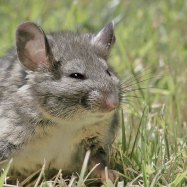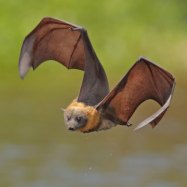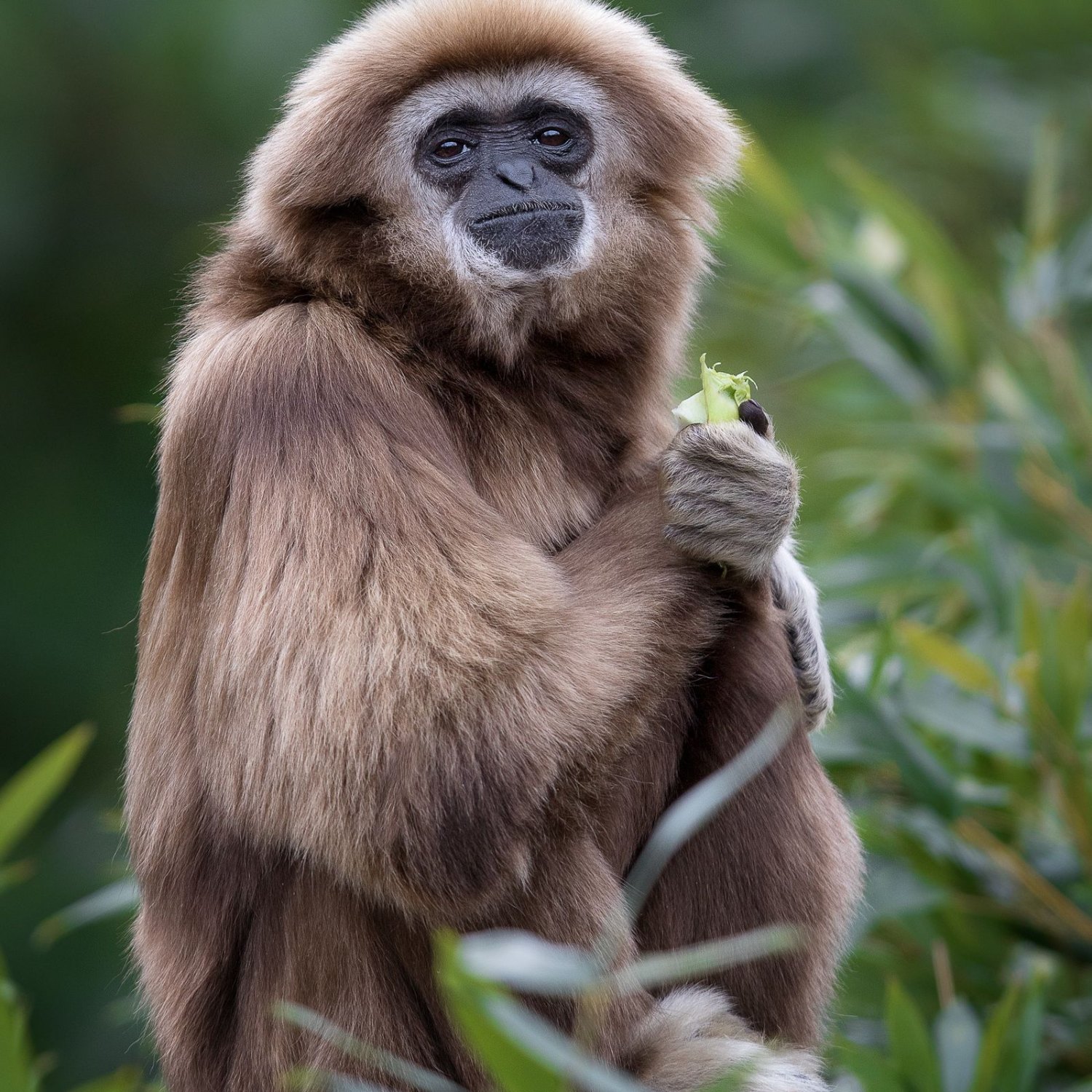
Gibbon
50 - 64 centimeters
Gibbons are slim and agile primates found in Asia, measuring 50-64 centimeters long. These playful creatures belong to the Hylobatidae family and can be seen swinging effortlessly through the forests of Sumatra, Borneo, Java, Thailand, and other countries. Experience the charm of these social animals in their natural habitat, while exploring countries like Malaysia, Cambodia, Laos, Vietnam, Myanmar, and China. #Gibbon #Animals #Wildlife #Asia
Animal Details Summary:
Common Name: Gibbon
Kingdom: Animalia
Habitat: Tropical rainforests
Gibbon: The Fascinating Ape of Southeast Asia
Gibbons, with their playful and boisterous nature, have captured the hearts of many. They are often referred to as the "songbirds" of the ape family, due to their incredible vocal abilities. But there is much more to these remarkable creatures than just their singing. In this article, we will delve deeper into the world of gibbons and explore their unique characteristics Gibbon.Gibbons belong to the genus Hylobates and are commonly known as gibbons. They are a type of primate and are closely related to humans, chimpanzees, and orangutans. With their distinct features and captivating behavior, gibbons hold a special place in the animal kingdom.
The Classification of Gibbons
To understand gibbons better, let's take a look at their classification. They belong to the kingdom Animalia, which includes all living organisms that are made up of cells and can move voluntarily. They are further classified under the phylum Chordata, which includes all animals that have a notochord, or a flexible rod-like structure, at some point in their life cycle.Gibbons belong to the class Mammalia, meaning they are warm-blooded animals with hair or fur covering their bodies. As primates, gibbons belong to the order Primates, which also includes humans, apes, and monkeys.
The family Hylobatidae consists of four genera and 18 different species of gibbons German Shepherd Guide. These species are divided into two families, namely the lesser apes, which include gibbons and siamangs, and the great apes, which include gorillas, orangutans, chimpanzees, and humans.
Habitat and Distribution
Gibbons are primarily found in the tropical rainforests of Southeast Asia. They are highly adapted to living in the forest canopy, where they spend most of their lives. Due to their agile and arboreal nature, they rarely come down to the forest floor.The geographical distribution of gibbons is primarily limited to Southeast Asia, particularly in countries such as Indonesia, Thailand, Malaysia, Cambodia, Laos, Vietnam, Myanmar, and China. In these countries, gibbons can be found in specific locations, including the islands of Sumatra, Borneo, and Java.
These animals are highly territorial and tend to stick to their designated areas in the forest. They mark their territories by leaving behind distinct calls and vocalizations that can be heard from miles away.
Physical Characteristics
Gibbons come in a variety of colors, ranging from black, brown, or white to a combination of these colors, depending on the species. Their coat color acts as camouflage in their forest habitat, making it difficult for predators to spot them.In terms of body shape, gibbons have a slender and agile build, with long arms and legs. They have a long, curved spine that allows them to swing from tree to tree effortlessly. With their specialized hands and feet, they are able to maintain a strong grip on branches.
Their average length ranges from 50 to 64 centimeters, and they weigh between 5 to 11 kilograms, with males being slightly larger than females. Their arms are longer than their legs, enabling them to leap distances of up to 10 meters between trees.
Feeding Habits
Gibbons are herbivores, which means their diet is primarily plant-based. Their main source of food includes fruits, leaves, flowers, and sometimes insects. They have a specialized digestive system that allows them to break down tough plant material efficiently.Being highly territorial creatures, gibbons have designated feeding areas within their territories. They carefully select what they consume, often picking ripe fruits that provide them with the necessary nutrients. This selective feeding behavior is crucial for their survival in the dense rainforest.
Social Structure and Behavior
Gibbons are unique in the sense that they mate for life. A male and female gibbon will typically form a monogamous pair, living and raising their offspring together. This bond between a male and female is reinforced by their distinct vocal duets, where they both sing together, creating beautiful harmonies.Their songs, or vocalizations, are an integral part of their daily lives and serve various purposes. They use it to communicate within their family, as well as to declare their territory to other gibbons. These vocalizations can be heard up to three kilometers away, and different species have distinct songs that are used to recognize each other.
Another fascinating aspect of gibbons' behavior is their swinging and acrobatic skills. They spend most of their time in the trees, leaping and swinging effortlessly. They have adapted to their forest environment and are capable of moving through the canopy at incredible speeds.
Risks and Threats
The biggest threat to the survival of gibbons is habitat loss and fragmentation. Deforestation is the primary cause of habitat loss, with large areas of forests being cleared for agriculture, logging, and urban development. This has resulted in a decline in the gibbon population, with some species facing critically endangered status.Gibbons are also hunted for their meat and are often captured for the illegal pet trade, further reducing their numbers in the wild. The loss of their natural habitat and poaching are the main reasons why many gibbon species are now on the endangered species list.
Conservation Efforts
Many organizations and individuals are working tirelessly to protect gibbons and their natural habitat. Conservation efforts include the establishment of protected areas, such as national parks and wildlife reserves, where these animals can thrive.Education and awareness programs are also crucial in ensuring the survival of gibbons. By educating local communities about the importance of these creatures in the ecosystem, we can reduce the demand for gibbon meat and the illegal pet trade.
In Conclusion
Gibbons may not be the largest or most well-known primates, but they have a significant role in their tropical rainforest habitats. Their beautiful vocalizations, unique social structures, and incredible agility make them a fascinating species to study and admire.However, with the increasing threats they face, it is crucial that we act now to protect these animals from extinction. By supporting conservation efforts and spreading awareness, we can ensure that gibbons continue to flourish in their natural environment for generations to come. Let us work together to preserve these remarkable creatures and their rainforest homes.

Gibbon
Animal Details Gibbon - Scientific Name: Hylobates
- Category: Animals G
- Scientific Name: Hylobates
- Common Name: Gibbon
- Kingdom: Animalia
- Phylum: Chordata
- Class: Mammalia
- Order: Primates
- Family: Hylobatidae
- Habitat: Tropical rainforests
- Feeding Method: Herbivore
- Geographical Distribution: Southeast Asia
- Country of Origin: Indonesia
- Location: Sumatra, Borneo, Java, Thailand, Malaysia, Cambodia, Laos, Vietnam, Myanmar, China
- Animal Coloration: Varies depending on species, ranging from black, brown, or white to a combination of these colors
- Body Shape: Slim and agile
- Length: 50 - 64 centimeters
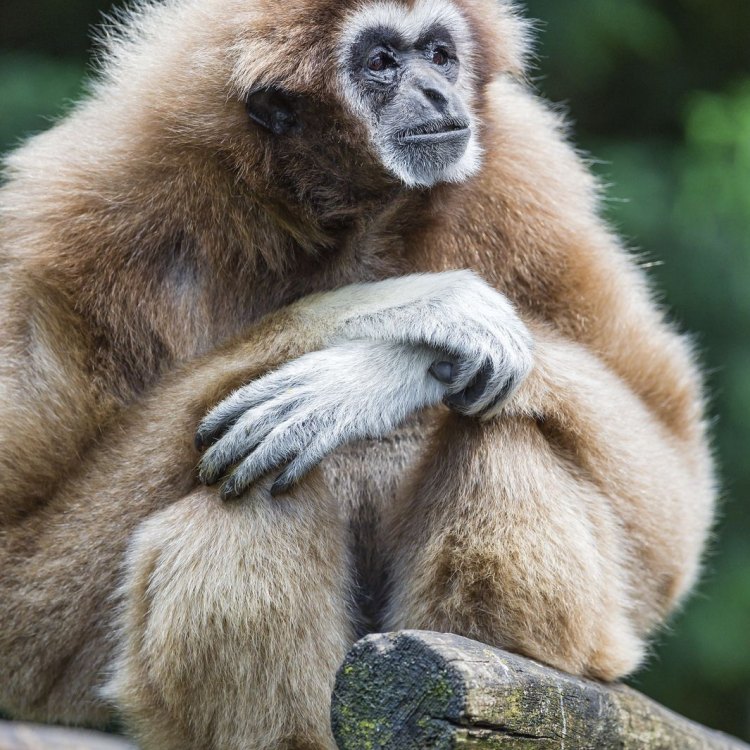
Gibbon
- Adult Size: 2.5 to 5.5 kilograms
- Average Lifespan: 25 to 30 years
- Reproduction: Sexual
- Reproductive Behavior: Monogamous pairs
- Sound or Call: Loud and distinct calls
- Migration Pattern: Non-migratory
- Social Groups: Form small family groups
- Behavior: Active during the day, spend most of their time in trees
- Threats: Habitat loss, hunting, and illegal pet trade
- Conservation Status: Endangered
- Impact on Ecosystem: Important for seed dispersal and maintaining forest health
- Human Use: Poaching for their body parts and the pet trade
- Distinctive Features: Long arms and fingers, agile climbers, lack a tail
- Interesting Facts: Gibbons are known for their incredible agility and acrobatics. They can swing through trees at speeds of up to 35 miles per hour
- Predator: Large cats, such as leopards and tigers
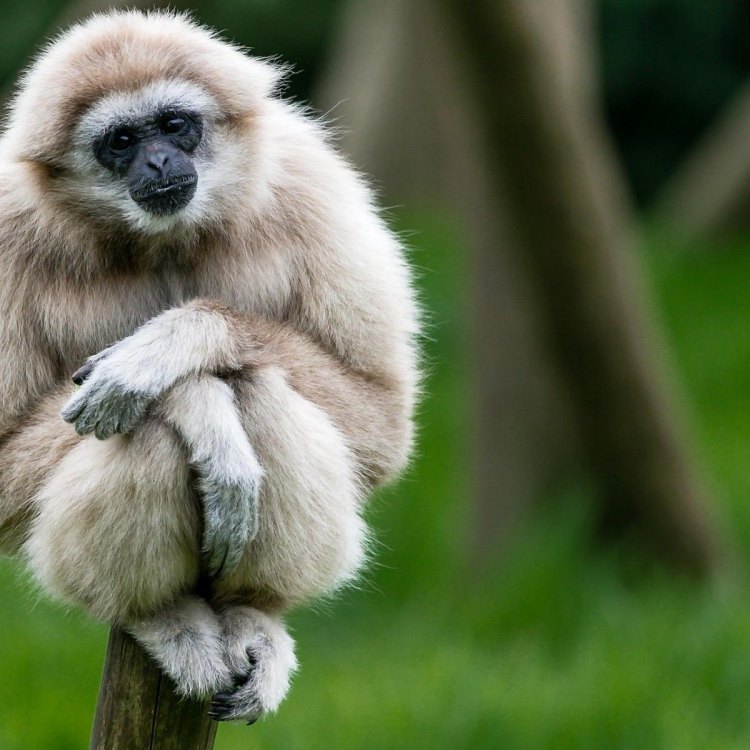
Hylobates
Gibbon: The Acrobatic and Endangered Apes of the Forest
The forest comes alive with the sound of loud and distinct calls. As the sun rises, the agile and acrobatic gibbons start their day, swinging through the trees with incredible speed and grace. These intriguing creatures, also known as the "lesser apes," are native to Southeast Asia and are closely related to orangutans, chimpanzees, and gorillas.Gibbons are fascinating creatures, and their unique features and behaviors make them a subject of interest and study for scientists and nature lovers alike PeaceOfAnimals.Com. In this article, we will explore the world of gibbons, from their distinctive features and behavior to their threats and impact on the ecosystem.
From Tiny Infants to Mighty Adults
With their long arms and slender bodies, gibbons may look like small apes, but they are actually incredibly strong and agile. They range in size from 2.5 to 5.5 kilograms, with males being slightly larger than females. They have a thick, soft, and silky fur that comes in various colors, such as black, dark brown, and light brown, depending on the species.Gibbons have a lifespan of 25 to 30 years in the wild, making them one of the longest-living primates. In captivity, they can even live up to 50 years. They reach sexual maturity at around 7 to 8 years of age, and females give birth to only one offspring at a time Goat. This low reproductive rate, coupled with their long lifespan, makes them particularly vulnerable to threats such as habitat loss and hunting.
One Love for Life
Gibbons are monogamous animals, forming pair bonds that can last a lifetime. Once they find their mate, they express their affection through grooming and vocalizations. They also engage in elaborate courtship rituals, including swinging and leaping together through the trees, advertising their bond to other gibbons in the area.Interestingly, mated pairs have been observed working together to defend their territory and offspring. They are fiercely protective of their family and will fight off any predators or potential threats.
Singing Their Way Through the Forest
One of the most distinctive features of gibbons is their loud and distinctive calls. These calls serve a variety of purposes, from communication with their mate to marking their territory and warning off other gibbons. Their songs can last up to 20 minutes and can be heard up to two miles away.Gibbons have a unique vocal structure that allows them to produce such loud and complex calls. They have a throat sac, which they inflate to amplify their calls, similar to a bagpipe. The male and female pairs often sing duets, creating a unique and mesmerizing harmony.
No Time for Travel: Non-Migratory Lifestyle
Unlike other primates such as chimpanzees and gorillas, gibbons do not migrate. They are highly territorial animals and have a strong attachment to their home range. They spend most of their time in the trees, only coming down to the ground occasionally to forage for food or to move to a new territory.Their home range can vary depending on the species, with some ranging as small as 17 hectares and others as large as 50 hectares. They use vocalizations and physical displays to defend their territory from other gibbons or predators.
The Joy of Family Groups
Gibbons are social animals and form small family groups consisting of a monogamous pair and their offspring. These groups typically consist of 2 to 6 individuals and are often led by the female. The young gibbons stay with their parents until they are around 7 years old, during which they learn crucial survival skills and social behaviors.Interestingly, while each group has its own territory, there is still significant interaction between different gibbon groups. These interactions serve various purposes, including finding potential mates or sharing information about food sources.
The Tree Dwellers: Active and Agile During the Day
Gibbons are active during the day, spending most of their time foraging for food and engaging in social behaviors. They are incredibly agile animals and are well adapted to life in the trees. Their long arms and fingers allow them to swing and brachiate through the trees with ease, reaching speeds of up to 35 miles per hour.They have long, powerful legs that enable them to leap up to 10 meters in a single jump. They can also use their feet like hooks to hang onto branches while using their hands to grab fruit or leaves. Such impressive agility allows them to navigate their forest homes with ease and avoid predators.
Threats to the Gibbons' Survival
Unfortunately, gibbons are facing numerous threats, making them one of the most endangered primate species in the world. The main threat to their survival is habitat loss. Deforestation for agricultural purposes, logging, and expanding human settlements has led to the destruction of their forest homes.Gibbons are also hunted for their body parts, which are used in traditional medicine. The illegal pet trade is another significant threat, as infant gibbons are often captured and sold as pets. These activities have resulted in a sharp decline in gibbon populations, with some species facing extinction.
Importance for the Ecosystem
Apart from being fascinating creatures, gibbons play a crucial role in maintaining the health of their forest habitat. As frugivores, they consume a variety of fruits, contributing to seed dispersal and ensuring healthy forest regeneration. This process is essential for maintaining the delicate balance of the ecosystem and ensuring the survival of other plant and animal species.Gibbons also help with pollination as they move from tree to tree in search of food. Their role in forest health cannot be overstated, making their conservation vital for the maintenance of biodiversity.
A Target for Human Use
Despite their protected status and conservation efforts, gibbons continue to face threats from human activities. The demand for their body parts for traditional medicine and the illegal pet trade has led to poaching and the depletion of gibbon populations. As a result, several conservation organizations are working towards ending this practice and protecting these endangered creatures.Distinctive Features and Surprising Facts
Gibbons have several distinctive features that make them stand out in the animal kingdom. Their long arms and fingers, lack of a tail, and agile climbing abilities are just a few of their unique characteristics. They also have a unique way of grooming, using their teeth to comb through their fur instead of their fingers.Apart from their physical features and behavior, gibbons are full of surprises. They are incredibly intelligent creatures, capable of problem-solving and using tools to obtain food. They are also known for their incredible vocalizations, and each species has its own distinct call, making it possible for researchers to identify them by their songs.
Predators of the Forest: Gibbons' Foes
While gibbons are highly adaptable creatures, they still face threats from predators. Large cats, such as leopards and tigers, are the main predators of gibbons. These felines are skilled hunters and are always on the lookout for vulnerable prey, including gibbons. However, the agility and speed of gibbons make them difficult targets, and they can often escape from these deadly predators.In Conclusion
Gibbons are incredible creatures, with their unique features, behavior, and important role in maintaining the forest ecosystem. As an endangered species, it is crucial to raise awareness about their conservation and the threats they face. We must take action to protect these acrobatic and majestic creatures before it's too late. With their incredible agility and loud calls, the forests would not be the same without the presence of these lesser apes. Let us do our part in ensuring their survival for future generations to marvel at and learn from.
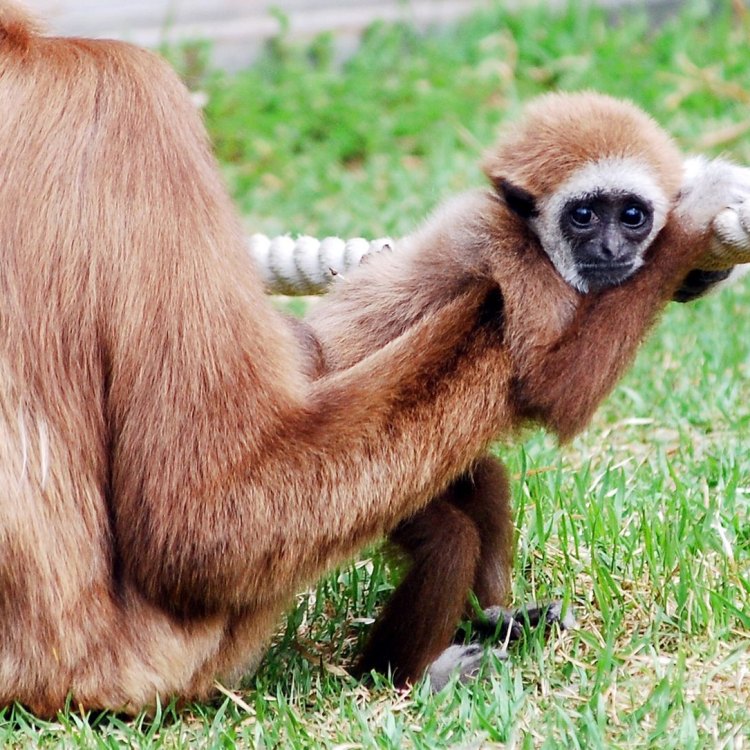
Gibbon: The Fascinating Ape of Southeast Asia
Disclaimer: The content provided is for informational purposes only. We cannot guarantee the accuracy of the information on this page 100%. All information provided here may change without prior notice.





